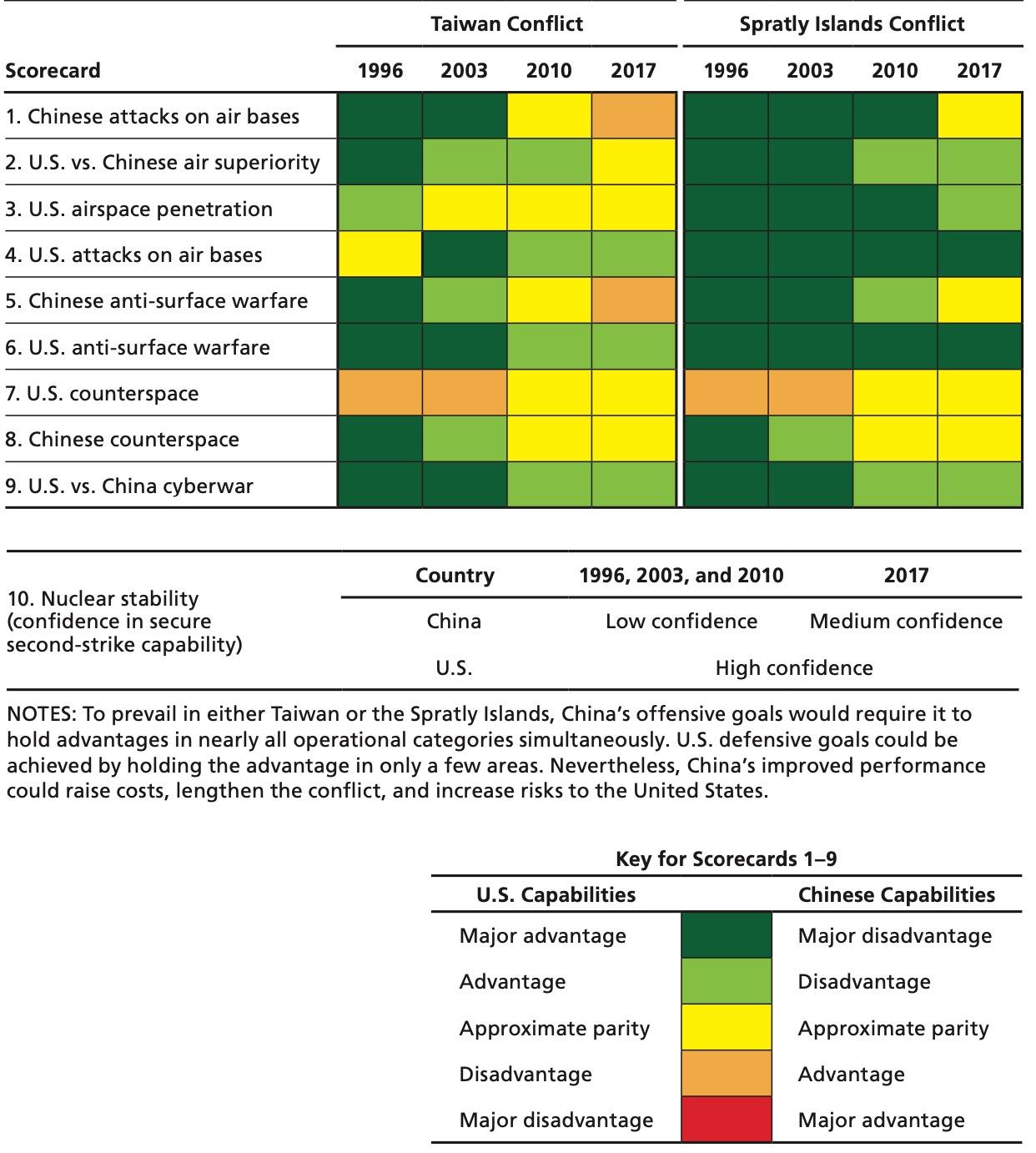
4 minute read
War Games: A Perfect Record
The acid test of military forces is how they perform in combat. Short of that, war games provide the next best indicator. U.S.-China war games in plausible conflict scenarios offer a discouraging operational picture of the local balance of power. Most of these war games are classified, and the most significant the most highly so. Particularly when the results are not favorable for Blue (Team USA), they are rarely publicized. Yet, one of the features of the American system is that former officials sometimes speak candidly after they leave government. As Senator John McCain’s former Senate Armed Services Committee Staff Director Christian Brose has stated bluntly: “Over the past decade, in U.S. war games against China, the United States has a nearly perfect record: We have lost almost every single time.”43
American strategists have been stunned by this scorecard and its operational implications. Summarizing a recent series of war games, former defense planner David Ochmanek observed that, when we fight China, “Blue gets its ass handed to it.”44 Ochmanek noted that “For years the Blue Team has been in shock because they didn’t realize how badly off they were in a confrontation with China.”45 Former Deputy Secretary of Defense Robert Work similarly found that “whenever we have an exercise, and when the Red Force really kind of destroys our command and control, we stop the exercise and say, ‘Okay, let’s restart. And, Red, don’t be so bad.’”46
In the war games, U.S. forces struggle to achieve superiority in key operating domains early in a conflict. According to Ochmanek, “all five domains of warfare are contested from the outset of hostilities.”47
43 Christian Brose, The Kill Chain: Defending America in the Future of High-Tech Warfare (New York: Hachette Books, 2020), p. xii.
44 “How the U.S. Military Fights Wars Today and in the Future,” event transcript (Washington, D.C.: Center for a New American Security, March 7, 2019), https://s3.amazonaws.com/files.cnas.org/documents/ANAWOW-Transcript07MAR19.pdf?mtime=20190408162617.
45 David Ochmanek, quoted in Richard Bernstein, “The Scary War Game Over Taiwan That the U.S. Loses Again and Again,” Real Clear Investigations, August 17, 2020, https://www.realclearinvestigations.com/articles/2020/08/17/ the_scary_war_game_over_taiwan_that_the_us_loses_again_and_again_124836.html. 46 “How the U.S. Military Fights Wars Today and in the Future,” event transcript (Washington, D.C.: Center for a New American Security, March 7, 2019), https://s3.amazonaws.com/files.cnas.org/documents/ANAWOW-Transcript07MAR19.pdf?mtime=20190408162617.
47 Ibid.
Likewise, as Work observed, “In the first five days of the campaign, we are looking good. After the second five days, it’s not looking so hot. That is what the war games show over and over and over.”48 Moreover, U.S. forces incur substantial losses of platforms and personnel. “We lose a lot of people,” Ochmanek acknowledged. “We lose a lot of equipment.”49 U.S. forward deployed forces, including airbases in Okinawa and Guam, surface ships, non-stealthy aircraft, and other exposed U.S. assets proximate to the battlespace, suffer early and persistent salvos of conventional precision munitions.50 In Brose’s summary: “The command and control networks that manage the flow of critical information to US forces in combat would be broken apart and shattered by electronic attacks, cyberattacks, and missiles. Many US forces in combat would be rendered deaf, dumb, and blind.”51
The U.S. military has had extensive recent combat experience, but much of it not that helpful for preparing to meet a peer competitor. As Work has explained, in those campaigns, the local balance of power at the outset of conflict “didn’t really matter… We would’ve crushed them like cockroaches once we assembled the might of America.”52 But a conflict with China today would be different. As Brose concluded, a war over Taiwan “could be lost in a matter of hours or days even as the United States planned to spend weeks and months moving into position to fight.”53
48 Ibid.
49 Ibid.
50 See Michael Peck, “Slaughter in the East China Sea,” Foreign Policy, August 7, 2020, https://foreignpolicy. com/2020/08/07/slaughter-in-the-east-china-sea/.
51 Brose (2020), xiii.
52 “How the U.S. Military Fights Wars Today and in the Future,” event transcript (Washington, D.C.: Center for a New American Security, March 7, 2019), https://s3.amazonaws.com/files.cnas.org/documents/ANAWOW-Transcript07MAR19.pdf?mtime=20190408162617.
53 Brose (2020), xv-xvi.
RAND Scorecard: Nine Operational Dimensions
These uncomfortable findings are supported by the most authoritative public assessment of the operational balance, the RAND Corporation’s “U.S.-China Military Scorecard.” It determined that, in a conflict over Taiwan, China would enjoy the advantage in U.S. airbase attack and anti-surface warfare. It would have approximate parity in establishing air superiority, penetrating U.S. airspace, and conducting and defending against counterspace operations. As the report concluded, with the U.S. no longer enjoying major advantages in nine key operational dimensions, “Asia will witness a progressively receding frontier of U.S. dominance.”54
Of course, there are choices the U.S. could make that would lead to changes on this scorecard in the years ahead. One that has been highlighted by former Joint Chiefs of Staff Vice Chairman Admiral James Winnefeld would be to develop new high-power microwave weapons for disrupting electronics using electromagnetic energy.55 But these choices are not the topic of this Report.
54 Eric Heginbotham, et al., The U.S.-China Military Scorecard: Forces, Geography, and the Evolving Balance of Power 1996-2017 (Santa Monica: RAND Corporation, 2015), https://www.rand.org/content/dam/rand/pubs/research_ reports/RR300/RR392/RAND_RR392.pdf. 55 James Winnefeld, “Don’t Miss the Boat on High-Power Microwave Defense,” Proceedings, May 2021, https://www. usni.org/magazines/proceedings/2021/may/dont-miss-boat-high-power-microwave-defense.




